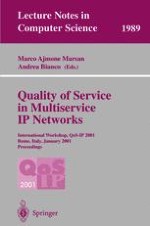IP is clearly emerging as the networking paradigm for the integration of the tr- ?c ?ows generated by a variety of new applications (IP telephony, multimedia multicasting, e-business, ...), whose performance requirements may be extremely di?erent. This situation has generated a great interest in the development of te- niques for the provision of quality of service (QoS) guarantees in IP networks. Two proposals have already emerged from the IETF groups IntServ and Di?- Serv, but research and experiments are continuing, in order to identify the most e?ective architectures and protocols. The Italian Ministry for University and Scienti?c Research has been funding a research program on these topics, named “Techniques for quality of service guarantees in multiservice telecommunication networks” or MQOS for short, in the years 1999 and 2000. At the end of its activity, the MQOS program has organized in Rome (Italy) in January 2001 the International Workshop on QoS in Multiserevice IP N- works (QoS-IP 2001), for the presentation of high-quality recent research results on QoS in IP networks, and the dissemination of the most relevant research results obtained within the MQOS program.
